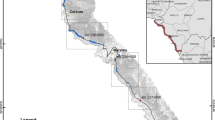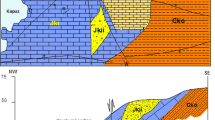Abstract
 The costs associated with rockfall risk are high. Many resources are invested in rock slope maintenance and stabilization, and protection measures to reduce rockfall hazards on transport infrastructures. However, few studies aim to evaluate the relative influence of the different factors (geometrical and material properties) affecting falling rock trajectories and the efficiency (retention capacity) of catchment areas. Numerous factors influence both the characteristics of rockfall motion, and their impact and stop-distance. Ritchie’s empirical research (1963) was the first to identify these characteristics and determine the expected impact distance of rockfalls depending on slope geometry. Later studies showed that Ritchie’s results were not as conservative as previously thought, and also that it was hard to apply his ditches on roadways due to their excessive depth (dangerous for vehicles) and width (expensive construction and maintenance). The Ritchie ditch has therefore been improved by computer simulation programs, and the proposed use of concrete walls or fences at the edge of the road. Optimization of the catchment area geometry requires systematic and quantitative analysis of the effect of each factor on rock stop-distance through application of a simulation model. With this aim, this study applies a CRSP 3D computer simulation model (Colorado DoT, USA) considering 75 different configurations of slope-ditch geometries, 4 types of materials and 9 size and shape combinations of falling rocks. In all we examined 270 different cases for hard rock and 180 for soft rock. A statistical analysis was performed with the simulated rock stop-distances to assess the different variables affecting rockfall motion.
The costs associated with rockfall risk are high. Many resources are invested in rock slope maintenance and stabilization, and protection measures to reduce rockfall hazards on transport infrastructures. However, few studies aim to evaluate the relative influence of the different factors (geometrical and material properties) affecting falling rock trajectories and the efficiency (retention capacity) of catchment areas. Numerous factors influence both the characteristics of rockfall motion, and their impact and stop-distance. Ritchie’s empirical research (1963) was the first to identify these characteristics and determine the expected impact distance of rockfalls depending on slope geometry. Later studies showed that Ritchie’s results were not as conservative as previously thought, and also that it was hard to apply his ditches on roadways due to their excessive depth (dangerous for vehicles) and width (expensive construction and maintenance). The Ritchie ditch has therefore been improved by computer simulation programs, and the proposed use of concrete walls or fences at the edge of the road. Optimization of the catchment area geometry requires systematic and quantitative analysis of the effect of each factor on rock stop-distance through application of a simulation model. With this aim, this study applies a CRSP 3D computer simulation model (Colorado DoT, USA) considering 75 different configurations of slope-ditch geometries, 4 types of materials and 9 size and shape combinations of falling rocks. In all we examined 270 different cases for hard rock and 180 for soft rock. A statistical analysis was performed with the simulated rock stop-distances to assess the different variables affecting rockfall motion.
Access this chapter
Tax calculation will be finalised at checkout
Purchases are for personal use only
Similar content being viewed by others
References
Andrew R, Hume H, Bartingale R, Rock A, Zhang R (2012). CRSP-3D user’s manual (Colorado Rockfall Simulation Program). Central Federal Lands Highway Division (FLH) of the Federal Highway Administration (FHWA). Publication No. FHWA-CFL/TD-12-007
Asteriou P, Saroglou H, Tsiambaos G (2012) Geotechnical and kinematic parameters affecting the coefficients of restitution for rockfall analysis. Int J Rock Mech Min Sci 54:103–113
Alejano LR, Pons B, Bastante FG, Alonso E, Stockhausen HW (2007) Slope geometry design as a means for controlling rockfalls in quarries. Int J Rock Mech Min Sci 44(6):903–921
Federal Highway Administration (1989) Rock slopes: design, excavation, stabilization. Publication nº. FHWA-TS-89-045. Turner-Fairbank Highway Research Center, McLean, Virginai
Giani GP, Giacomini A, Migliazza M, Segalini A (2004) Experimental and theoretical studies to improve rock fall analysis and protection work design. Rock Mech Rock Eng 37(5):369–389. doi:10.1007/s00603-004-0027-2
Gomes GJC, Sobreira FG, Lana MS (2012) Design of highway rock slopes catchment area. Road Mater Pavement Des 13(2):396–402
Hoek E (1987) Rockfall—A program in Basic for the analysis of rockfalls from slopes. Golder and Associates, Vancouver BC
Labiouse V, Heidenreich B (2009) Half-scale experimental study of rockfall impacts on sandy slopes. Nat Hazards Earth Syst Sci 9(6):1981–1993
Nishikawa Y, Masuya H, Moriguti Y (2012) Three dimensional simulation of rockfall motion with consideration of roughness of the slope surface. Trans Japan Soc Comput Eng Sci 2012: 3
Okura Y, Kitahara H, Sammori T (2000) Fluidization in dry landslides. Eng Geol 56:347–360
Pantelidis L (2010). Rock catchment area design charts. In: GeoFlorida 2010: advances in analysis, modelling & design (GSP 199). Department of Civil Infrastructure Engineering, Technological Educational Institute of Thessaloniki, Greece
Pfeiffer T, Bowen T (1989) Computer simulation of rockfalls. Environ Eng Geosci 26(1):135–146
Pfeiffer TJ, Higgins JA (1990) Rockfall hazard analysis using the Colorado rockfall simulation program. Transportation Research Record, No. 1288, National Research Board, Washington DC, pp 117–126
Pierson LA, Davis SA, Pfeiffer TJ (1994) The nature of rockfall as the basis for a new catchment area design criteria For 0.25H:1V Slopes. Oregon Department of Transportation, report no. FHWA-OR-GT-95-05
Pierson LA, Gullixson CF, Chassie RG (2001) Rockfall Catchment area design guide. Final report SPR-3(032). Oregon Department of Transportation Research Group. U.S. Federal Highway Administration. Report nº: FHWA-OR-RD-02-04
Rodriguez-Losada JA, Hernandez-Gutierrez LE, Olalla C, Perucho A, Serrano A, del Potro R (2007) The volcanic rocks of the Canary Islands. Geotechnical properties. In: Malheiro & Nunes (eds) Volcanic rocks. Taylor & Francis Group, London, pp 53–57. ISBN 978-0-415-45140-6
Rodriguez-Losada JA, Hernandez-Gutierrez LE, Olalla C, Perucho A, Serrano A, Eff-Darwich A (2009) Geomechanical parameters of intact rocks and rock masses from the Canary Islands: implications on their flank stability. J Volcanol Geothermal Res 182(1–2):67
RocScience (2011) Computer program RocFall. RocScienceInc, Toronto, Canada
Ritchie AM (1963) Evaluation of rockfall and its control. Record, 17 Highway Research Board, pp 13–28
Santamaría Arias J, Ballester Muñoz F, Luis Fonseca R, Torres Vilas JA (1996) Protección contra desprendimientos de rocas, pantallas dinámicas. Centro de Publicaciones del Ministerio de Fomento, Madrid. ISBN 84-498-0253-9. D.L.: M-40877-1996
Spang RM, Rautenstraunch RW (1988) Empirical and mathematical approaches to rockfall protection and their practical application. Rock Mech Rock Eng 23:207–209
Vijayakumar S, Yacoub T, Curran J (2011) A study of rock shape and slope irregularity on rock fall impact distance. 45th US rock mechanics/geomechanics symposium
Wu S (1987) Rockfall evaluation by computer simulation. Transportation research record, no. 1031, National Research Board, Washington DC, pp 1–5
Ye SQ, Chen HK, Xu J (2011) Rockfalls movement mode and movement features by field tests. Tumu Jianzhu yu Huanjing Gongcheng/J Civil, Arch Environ Eng 33(2):18–23+44
Ye SQ, Shangqing G, Yang ZY, Hui L (2014) Model test for falling-rock motion characteristics on composite slope section. Electron J Geotech Eng 19 U:6161–6171
Yepes J, García-González C, Franesqui MA (2017) Rockfall hazard mitigation using ditch charts modeled with CRSP-3D. In: Landslide research and risk reduction for advancing culture of living with natural hazards. 4th World Landslide Forum
Author information
Authors and Affiliations
Corresponding author
Editor information
Editors and Affiliations
Rights and permissions
Copyright information
© 2017 Springer International Publishing AG
About this paper
Cite this paper
Yepes, J., García-González, C., Franesqui, M.A. (2017). Analysis of Rockfall Stop-Distance Factors with CRSP-3D in Volcanic Talus. In: Mikoš, M., Arbanas, Ž., Yin, Y., Sassa, K. (eds) Advancing Culture of Living with Landslides. WLF 2017. Springer, Cham. https://doi.org/10.1007/978-3-319-53487-9_56
Download citation
DOI: https://doi.org/10.1007/978-3-319-53487-9_56
Published:
Publisher Name: Springer, Cham
Print ISBN: 978-3-319-53486-2
Online ISBN: 978-3-319-53487-9
eBook Packages: Earth and Environmental ScienceEarth and Environmental Science (R0)




